The Intel Haswell-E CPU Review: Core i7-5960X, i7-5930K and i7-5820K Tested
by Ian Cutress on August 29, 2014 12:00 PM ESTCPU Benchmarks
The dynamics of CPU Turbo modes, with both Intel and AMD, can cause concern during environments with a variable threaded workload. There is also an added issue of the motherboard remaining consistent, depending on how the motherboard manufacturer wants to add in their own boosting technologies over the ones that the CPU manufacturer would prefer they used. In order to remain consistent, we implement an OS-level unique high performance mode on all the CPUs we test which should override any motherboard manufacturer performance mode.
HandBrake v0.9.9: link
For HandBrake, we take two videos (a 2h20 640x266 DVD rip and a 10min double UHD 3840x4320 animation short) and convert them to x264 format in an MP4 container. Results are given in terms of the frames per second processed, and HandBrake uses as many threads as possible.
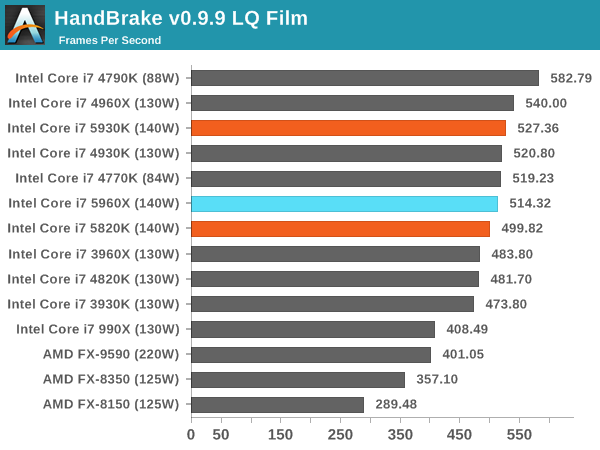
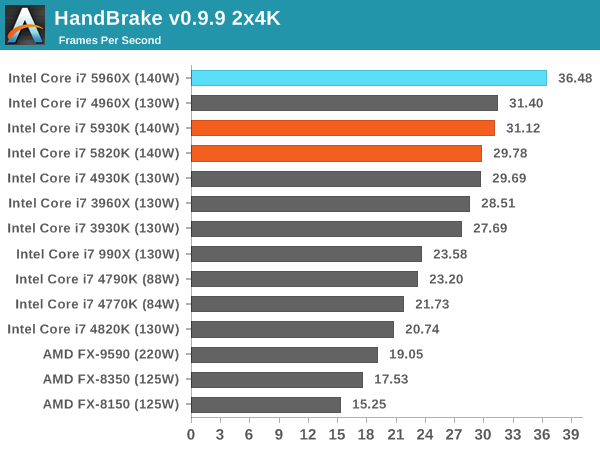
The variable turbo speeds of the CPUs results in a small difference in low quality conversion, and the high single core frequency of the 4790K wins there. For 4K conversion the problem becomes more parallel and the extra cores of the 5960X push it ahead of the pack. The 5930K and 5820K are both behind the 4960X however.
Agisoft Photoscan – 2D to 3D Image Manipulation: link
Agisoft Photoscan creates 3D models from 2D images, a process which is very computationally expensive. The algorithm is split into four distinct phases, and different phases of the model reconstruction require either fast memory, fast IPC, more cores, or even OpenCL compute devices to hand. Agisoft supplied us with a special version of the software to script the process, where we take 50 images of a stately home and convert it into a medium quality model. This benchmark typically takes around 15-20 minutes on a high end PC on the CPU alone, with GPUs reducing the time.
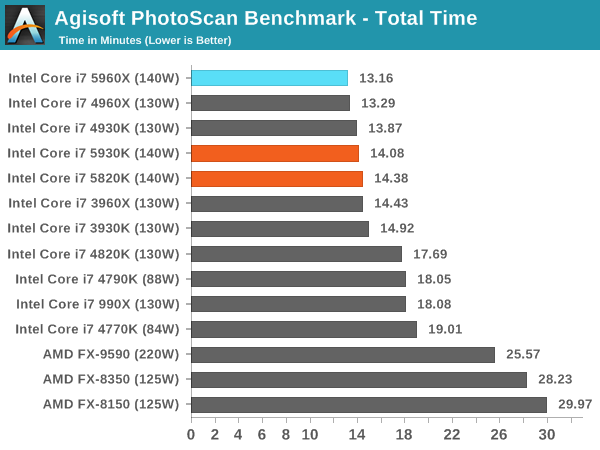
Photoscan's four separate components rely on different amounts of high frequency vs. many cores: check our Bench database for more detailed results but overall the 5960X comes out on top. That being said, the 5820K is less than 40% of the price and is only 1.2 minutes behind.
Dolphin Benchmark: link
Many emulators are often bound by single thread CPU performance, and general reports tended to suggest that Haswell provided a significant boost to emulator performance. This benchmark runs a Wii program that raytraces a complex 3D scene inside the Dolphin Wii emulator. Performance on this benchmark is a good proxy of the speed of Dolphin CPU emulation, which is an intensive single core task using most aspects of a CPU. Results are given in minutes, where the Wii itself scores 17.53 minutes.
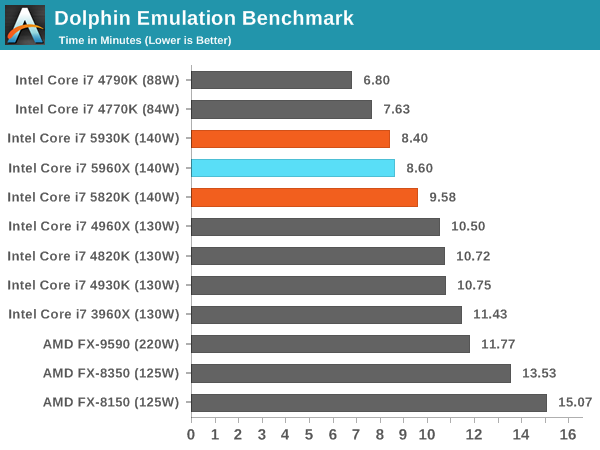
Dolphon loves single core speed and efficiency, meaning the 4790K wins out again. Interestingly the large L3 cache of the 5960X also helps here against the 5820K, despite the 5820K having a higher single thread frequency.
WinRAR 5.0.1: link
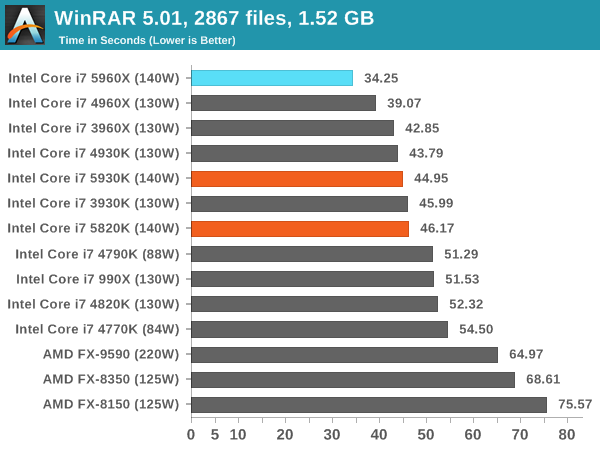
WinRAR is a variable thread workload, but more cores still wins out. Interestingly the xx60X CPUs are ahead of the xx30K CPUs followed by the xx20K. After this comes the 4790K, and then the 990X on par, showing how far three generations of Intel CPU have developed.
PCMark8 v2 OpenCL
A new addition to our CPU testing suite is PCMark8 v2, where we test the Work 2.0 and Creative 3.0 suites in OpenCL mode.
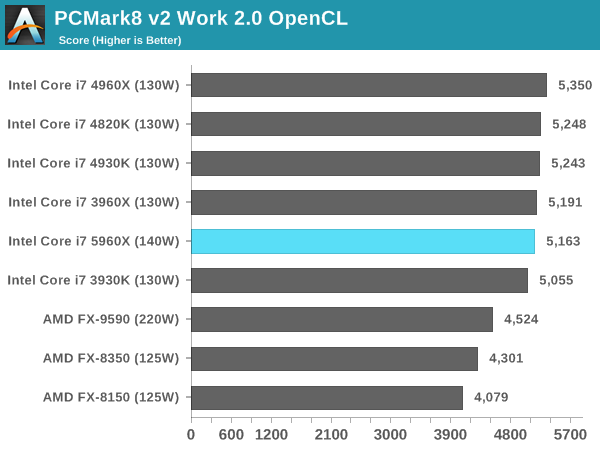
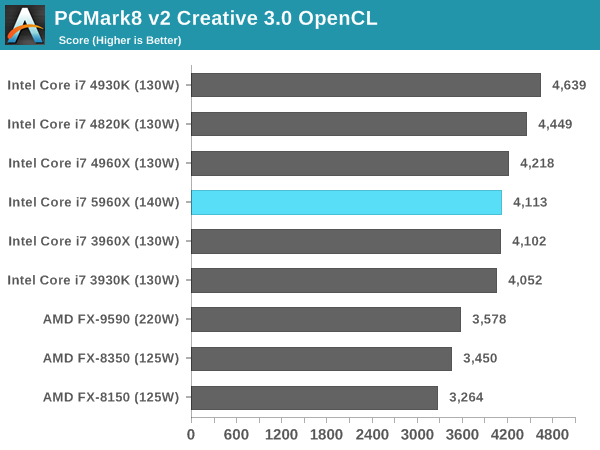
PCMark v8 relies on a number of factors, and it would seem that frequency is preferred over cache and memory. Interestingly the 4930K beat the 4960X in the Creative Suite with no obvious explanation.
Hybrid x265: link
Hybrid is a new benchmark, where we take a 4K 1500 frame video and convert it into an x265 format without audio. Results are given in frames per second.

Converting 4K video gets another step in the preference for more cores in Hybrid x265. The 5820K matches the 3960X, showing the progression of CPU generational development.
Cinebench R15
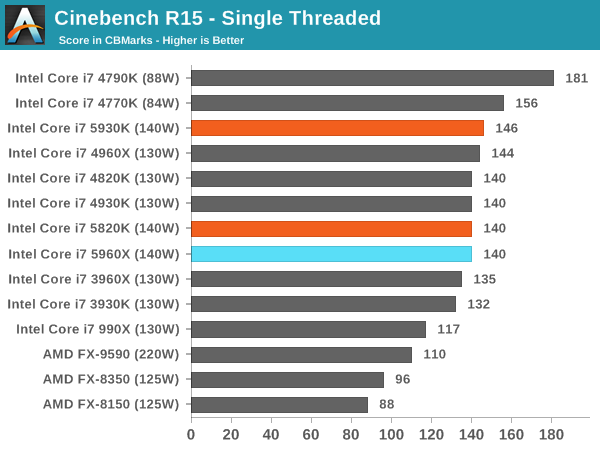
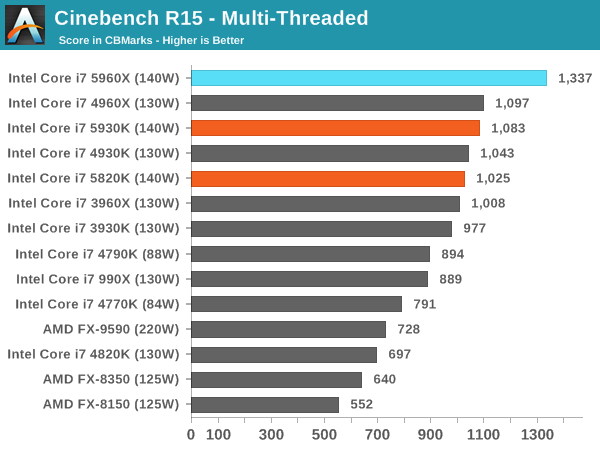
3D Particle Movement
3DPM is a self-penned benchmark, taking basic 3D movement algorithms used in Brownian Motion simulations and testing them for speed. High floating point performance, MHz and IPC wins in the single thread version, whereas the multithread version has to handle the threads and loves more cores.
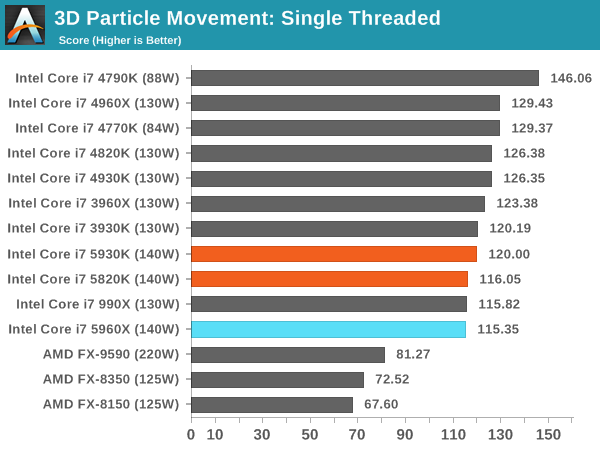

FastStone Image Viewer 4.9
FastStone is the program I use to perform quick or bulk actions on images, such as resizing, adjusting for color and cropping. In our test we take a series of 170 images in various sizes and formats and convert them all into 640x480 .gif files, maintaining the aspect ratio. FastStone does not use multithreading for this test, and results are given in seconds.
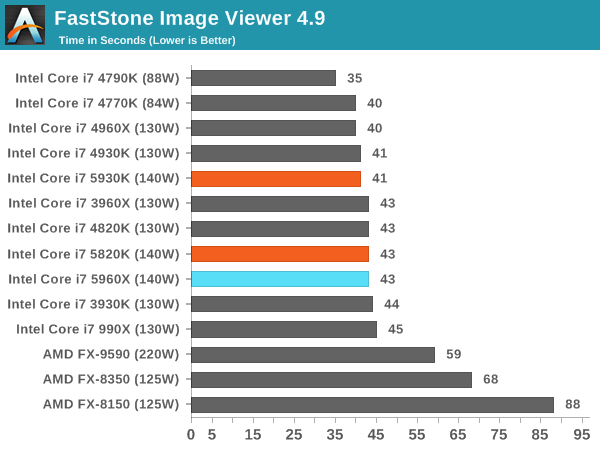
FastStone is a purely single threaded exercise, showing here how the lower core CPUs with high turbo perfom best, and by quite a margin.










203 Comments
View All Comments
TiGr1982 - Tuesday, September 2, 2014 - link
Right. Gulftown was the 32 nm shrink of 45 nm Nehalem. However, in that case there was no associated IPC change (except AES addition in Gulftown), so in light-threaded tasks there was no performance difference between the two (except AES), so people often informally confuse the two, despite the fact that Gulftown has two more cores due to the 32 nm instead of 45 nm.SantaAna12 - Friday, August 29, 2014 - link
Good timing Anandtech!I might have missed it, but any variance at 1440?
danjw - Friday, August 29, 2014 - link
"Intel has decided to made the lower cost Haswell-E processor ..." I think it should be /made/make.Ian Cutress - Monday, September 1, 2014 - link
Thanks for the catch, edited :)bernstein - Friday, August 29, 2014 - link
Thanks for this review. It's now clear, this platform is for an extremely narrow target audience, requiring the most computational speed on a single mainboard, requiring 4 RAM channels or 40pcie lanes but be cheaper than xeon e5 yet not need ecc.i truly wonder what prcatical application there is? i mean it can neither mission critical or scientific stuff becuase that would require ecc... gaming at 8k? (no 4k works fine on a 4790K with two titans)
bombardira - Friday, August 29, 2014 - link
video editing, 3d rendering, audio/photo work should still benefit from lots of cores.Kain_niaK - Friday, August 29, 2014 - link
Yeah until you stop upgrading and build a rendering farm that can split the workload over multiple systems. Then you just keeping buying more of the price/quality stuff. CPU's or GPU's.Brigaid - Friday, August 29, 2014 - link
"Modules should be available from DDR3-2133 to DDR3-3200 at launch, with the higher end of the spectrum being announced by both G.Skill and Corsair."Page 1. Shouldn't these both say DDR4-?
Ian Cutress - Monday, September 1, 2014 - link
Thanks for the catch, edited :)apexjr - Friday, August 29, 2014 - link
Ian - How come we didn't see any tests of over clocking with the 6 core 5930k and 5920k? I had just purchased a i7-4790k that isn't even installed yet. I am not just a gamer, I do video and photo work as well and I am constantly CPU limited. The X cpu is way to expensive, so these others particularly the 5920k overclocked might be a perfect sweet spot for a lot of people.